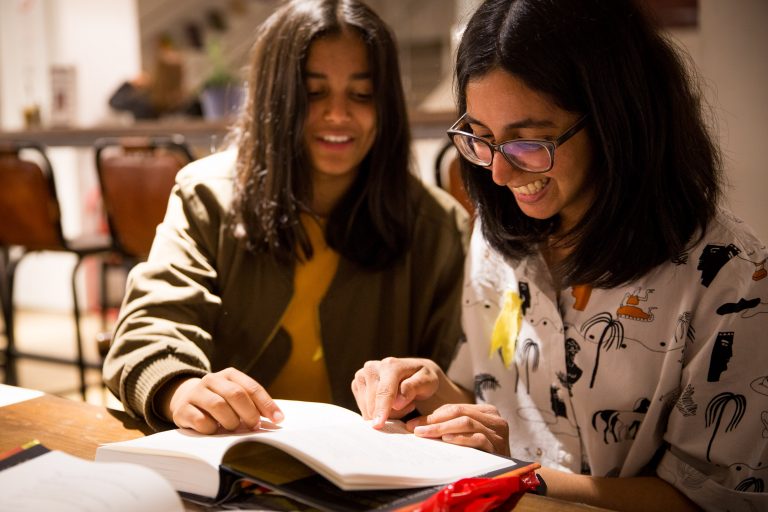
Image by Francisco Osorio/Flickr, Attribution.
How To Game Yourself To Make Great Art
The dark bar was so packed that people were lined up on staircases and spilling over the balcony. It was loud. It was sweaty. It was hip. There was a sort of visceral anticipation in the air. I was there, too, beer in hand, looking around, filled with fear. I was 19 years old, about to take the tiny platform stage at the Nuyorican Poets Café in New York City and read a poem, and I was terrified. And yet, as I perched on a stool and waited for the host to get the evening started, I yawned repeatedly.
I thought of this strange juxtaposition recently when I heard novelist George Saunders tell media mogul Tavi Gevinson that artists have to, in a sense, game themselves in order to do their best work. He was talking about how he managed to write his first novel, Lincoln in the Bardo. Basically, he pretended — even to himself — that he wasn’t writing a novel. That way, his mind couldn’t go to all the scary places that a mind might go if it thinks it is doing something with gravitas and risk.
As I heard this, it occurred to me that I frequently game myself in order to get scary things done. When I yawned at the Nuyorican Poets Café in order to trick myself into thinking that I was bored, when really I was about to throw up. When I was writing my first book, Perfect Girls, Starving Daughters, I first pretended I was writing a letter to my cousin Anna, whom I love very much and sometimes burden with unsolicited advice (as a big cousin is obligated to do).
That happened again for The New Better Off, my latest book; in that case, as I was flailing around feeling unsure of what it was, exactly, that I was trying to say, I wrote and actually sent a letter to my friend. Some of the language from that letter made it into the book proposal, which helped me sell the book. When I gave my first TED talk, I developed a sort of rebellious-teenager stance to the whole enterprise as I wandered around the green room beforehand, thinking to myself, “Screw this. Screw the hype. TED isn’t that awesome, anyway.”
Deep down, the truth is that I, too, thought TED was really awesome and that I wanted, more than anything, to give a killer talk. But I submerged earnest, eager Courtney and let eye-rolling, over-it Courtney take over for a little while because I knew — on some totally subconscious level — that she would be able to handle the bright lights, the thousands of people in the audience, and the prospect of making something meaningful for such a huge platform far better.
Gaming yourself is related, to some extent, to “fake it till you make it” — an idea that when you feel like an imposter in a particular context, you just have to put your head down and pretend you’re feeling confident until you actually are. It’s also related to the much-discussed “power pose” that psychologist Amy Cuddy recommends that people take if they’re headed into a situation that makes them nervous. Cuddy has said,
“Our nonverbals govern how we think and feel about ourselves. Our bodies change our minds.”
In a sense, Cuddy is advocating that you game your mind using your body. But what Saunders was talking about, and what I realize I do, is game my heart using my mind. If I can trick myself into thinking the stakes are lower than they really are, then I can get out of my own way emotionally and let my gift flow more freely. There’s a directness, a playful quality, a delight, that can exist within the context of this game; it isn’t weighed down with all the self-seriousness of the artist trying to make something worthy of the world. Even Saunders, a professor, bestseller, and highly awarded and beloved writer, fools himself into thinking he’s just arranging words on the page rather than writing something that thousands of fans are waiting for with bated breath (and, no doubt, a few itchy critics). Maybe you have to get even better at tricking yourself the more successful you get? As the stakes get higher and higher, your game has to get stronger and stronger.
Interestingly, even scientific studies of writer’s block — that frightening term for what happens when writers can’t write despite their best efforts—find that the cure is not looking your artistic demons right in the eyes. Writers who were led through free-association visual exercises and wrote about them were able to unlock their own creative force better than those who attended group therapy sessions where they actually talked about their block. In other words, sometimes talking ad nauseam about how nervous you are about something is less effective than just pretending you’re not even doing that something in the first place.
Why? As I see it, because the exercises inspire an almost childlike innocence about creative sensibility. It’s not about publishing the great American novel or the perfect poem or the well-made play. It’s about drawing strange and wonderful connections between the moments that one experiences on a daily basis. Nothing more, nothing less. Just noticing and remixing and making meaning out of these brief days that we are on this earth and lucky enough to look around. And the funny thing? All that playfulness can accidentally lead to profound art — whether your subconscious knew it or not.
So go on, game yourself. The world is waiting for your masterpiece by way of your slacker, rebel, silly, nonsensical, inefficient, brave self.


Share your reflection